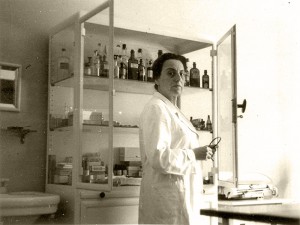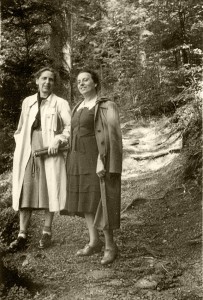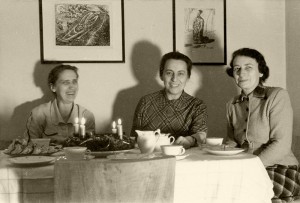
In contrast to her brother, who had emigrated to the USA, Sandels felt responsible for her elderly mother and stayed in Frankfurt. In order to facilitate the later emigration, she married Dr. Walter Oppenheimer, who had added his wife’s name on his own visa application.
However, it was much too late for Dr. Antonie Sandels-Oppenheimer to emigrate after her mother’s death. The financial independence and the established communal living arrangement of the two women Sandels and Herberg came to an end in the late 1930’s. According to the Gestapo instruction Dr. Sandels had to move to the children’s home at Hans-Thoma-Strasse 24. Sandels was ordered to appear for the large deportation on 24 september 1942 at the “Großmarkthalle” (the wholesale market was the meeting place for the jews to be deportated). She talked about suicide with her colleagues at the children’s home. But she escaped during an unguarded moment to her friend Margarete who lived opposite of the childrens home in Gartenstrasse 51.
Margarete spread pepper in order to cover her tracks in case she was pursued by tracking dogs. After the Gestapo rang the doorbell twice Antonie Sandels crept into a small room under the roof. Margarete Herberg looked for an alternate accommodation for Sandels, because she was afraid of further Gestapo searches. Her hairdresser recommended her to contact Adam Imhof, whom she referred to as being very trustworthy. Imhof had worked for years as a chauffeur for the Jewish owner of the Adler-Werke, and Sandels was housed for the next few months in an apartment at the back of his courtyard. Herberg brought groceries every few days.


She was able to siphon off additional groceries as she worked for Kurt Thomas, the director of the “Musisches Gymnasium” and was also friendly with the cook. Sandels returned to Margarete Herberg’s apartment at Gartenstrasse 51 at the end of 1943.
Sandels was not allowed to enter the bomb shelter in the house, although there were ever more frequent air raids. That was the reason that Herberg completed an apprenticeship as bomb warden. This position allowed her to decide who could enter the bomb shelter and the end of the shelter stay. So Sandels was the last one to come down into the shelter and hid behind the door. The house was severely damaged during one of these air raids and Sandels and Margarete Herberg’s son used this convenient opportunity to escape to Heidelberg. They found a place to stay in a small house owned by the cook of the “Musisches Gymnasium” in the tiny village Korb am Neckar. Antonie Sandels applied for an air raid victim ID under the name of Eva Imhof and subsequently received a ration card. After several more moves Margarete Herberg, her son and Dr. Antonie Sandels experienced freedom in Korb.
See: Petra Bonavita: Mit falschem Pass und Zyankali, Stuttgart 2009, page 64. Frank Moraw: Illegal von Frankfurt nach Heidelberg – Jahrbuch zur Geschichte der Stadt 2011, Heidelberg 2010, pages 231-239.